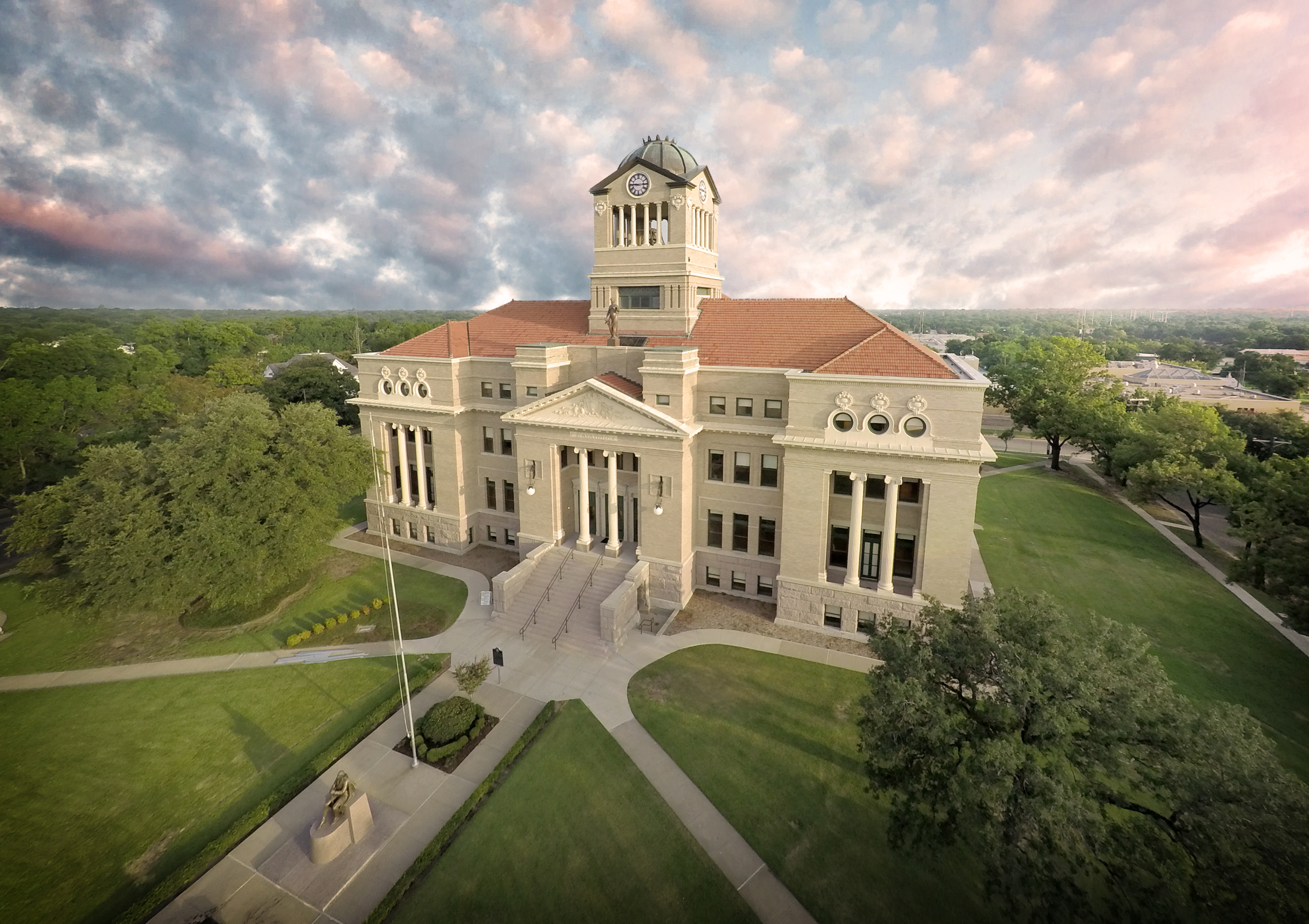The original Bexar County Courthouse was designed by famed architect James Riely Gordon and completed in 1896. Last summer the county celebrated the completion of its $9.1 million restoration project funded by the Texas Historical Commission (THC) Texas Historic Courthouse Preservation Program, the Hidalgo Foundation of Bexar County, and other general funds. Restoration projects inside and around the building stretched over five years, but the county was able to keep the building open for business throughout.
The project included the restoration of the original 1896 double-height courtroom, one of the most elaborate designed by Gordon, which now boasts impressive coffered ceilings, gilding on the plaster moldings and capitals, and 12 decorative windows based on the design of the rose window of San Antonio’s iconic Mission San José. The overall project also included the removal of two additions built by architect Edward Gondeck in 1963 and 1972 (see details below) and the restoration of the courthouse’s original exterior.
Over time, the two double-height courtrooms became lost within the building, giving way to four smaller, single-story courtrooms. Once the courtrooms were vacated, the rooms were gutted down to the original masonry walls and surviving plaster ceiling. The steel-framed, intermediate floor was then removed, revealing a raw shell of the original double-height courtroom. Unfortunately, there are no surviving plans of the original 1896 building. The only photographic evidence that was found of the courtroom was a grainy newspaper photograph of a murder trial in 1914. This photo proved vital in determining the original courtroom configuration, wainscot details and light fixture locations.
Old Commissioners Court meetings and written observations from James Riely Gordon indicated that a segregated balcony was constructed within the courtroom, but was removed sometime before 1914 for unknown reasons. The overall size of the balcony was determined by joist pockets found within the east masonry wall.
The existing plaster coffered ceiling had two false beams running east/west that had to be replicated using conventional metal framing and cast plaster moldings that matched the existing molding profiles still in place. Within each coffered area of the ceiling, and on select wall surfaces, acoustical plaster was installed to seamlessly blend in with the existing plaster finishes. For the plaster capitals, the originals were completely removed years ago; luckily there were existing plaster capitals in the attic that are original to the building. These capitals were laser scanned in place to create an exact replica for the restored courtroom. Upon completion, the capitals were hand painted along with the rest of the coffered ceiling, using colors that were identified in a paint analysis that was conducted during the design phase.
The Bexar County Courthouse was rededicated in July 2015. – A portion of this information was provided by David Hannan Jr., Principal | FISHER HECK ARCHITECTS

Removal of Gondeck Additions
The Bexar County Courthouse restoration project included the removal of the 1963 and 1972 building additions that were attached to the west and southwest side of the courthouse with a small wrap around the south facade. Much of the original west facade remained in place.
The 1972 addition had to be removed first. In fact, the demolition was done by hand with workers carefully removing one floor at a time where the two buildings abutted.
This removal and reconstruction, designed by Alamo Architects, encompassed the repair, rehabilitation, and reconstruction of the west entry portico along with the west patio, windows, doors, window guards, areaways, terracotta cornices, stone balustrade, guardrails, fire escapes, copper flashing and light fixtures. The scope also included “disconnecting” all infrastructure from the original courthouse, all while the courthouse remained in continuous use.
Specifically, workers cleaned and re-pointed the exterior stone, terra cotta and granite. Missing pieces of stone were reproduced using stone from the original quarry, and damaged stone was patched. Damaged and missing terra cotta pieces were re-created using molds from original pieces. The historic windows were also restored, and missing windows were reconstructed to replicate the original windows.
Finally, this portion of the project included new accessible entries, repairs to the basement walls, and added waterproofing. – Information provided by Salvador Garcia Jr., Associate Principal, Alamo Architects, Inc.

Navarro County Courthouse – Corsicana
The Navarro County Courthouse was built in 1905 and is an example of a Beaux-Arts or Neo Classical design. The county capitol was designed by J.E. Flanders of Dallas, a significant architect of the period, and built by General Supply and Construction Company of Fort Worth. The courthouse was recently restored in a $10.1 million project that included both interior and exterior preservation and reconstruction, as designed by 1113 Architects of Georgetown and constructed by Phoenix Restoration and Construction of Dallas. The project was part of the THC Texas Historic Courthouse Preservation Program.
This beautiful temple of justice was built of red Burnet granite and gray brick with a red terra-cotta tile roof. Sited on a sloping tree-covered square and surrounded by early 20th and late 19th century homes that are now offices, the courthouse’s most dominant external feature is the open clock tower, which remained empty (without a clock) until 1923.
During restoration the trees that obscured the view of the courthouse were removed. A 15-foot-tall Lady Justice statue was built to replicate the one on the roof of the courthouse shown in early photographs.
The interior of the building is unusual in that the lobby is square in shape, as opposed to the traditional circular rotunda of many Texas courthouses. The central vertical space is dominated by a ceiling of stained glass panels, with ionic columns made of plaster with a rare scagliola finish and extensive ornamentation throughout the public spaces. In fact, the most exciting discovery about this courthouse was the beautiful scagliola finished columns. The master plan indicated these to be either a marble or terrazzo finish. However, they are actually finished with the paint and plaster finish known as scagliola, which is rarely seen west of the Mississippi River. The columns were in beautiful condition, needing only minor repairs along with cleaning and waxing to restore them to their original beauty. This is a significant find, as Navarro County Courthouse is one of the few structures that displays this ancient technique.
Navarro County rededicated its newly restored courthouse on July 1, 2016. – Information provided by Thomas M. Nichols, R.A., 1113 Architects










